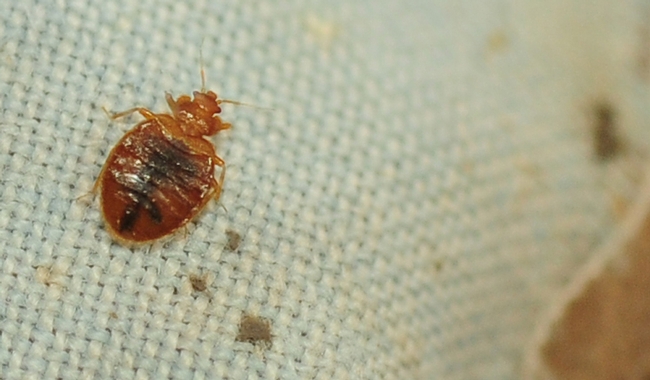
There's a good reason why they're called "the menace in the mattress." The mattress is one of their hiding spots.
They? Bed bugs. Parasites that feed on human blood.
"Bed bug infestations are rampant locally, nationally and globally," says Tanya Drlik, integrated pest management (IPM) coordinator of Contra Costa County who will speak at the May 3rd meeting of the Northern California Entomology Society, to be held in the Harry H. Laidlaw Jr. Honey Bee Research Facility on Bee Biology Road, UC Davis.
“We’ve had a reprieve from bed bugs for about 50 years, but now they’re back,” said Drlik, who will discuss “The Resurgence of Bed Bugs and Current Effective Control Methods” at 9:45 a.m. in the Laidlaw conference room.
The society (membership is open to everyone) will meet from 9:15 a.m. to 2:30 p.m. Drlik is one of five speakers on topics ranging from bed bugs to lacewings to endangered species.
Drlik, who formed the Bed Bug Task Force to help prepare Contra Costa County to meet the challenges of the mounting bed bug infestation, says that bed bugs “have no regard for wealth or class—everyone is vulnerable. Bed bugs can be found all across the country in apartment buildings, hotels and motels, private residences, hospitals, waiting rooms, fire station, taxis and buses…and the list goes on. They’ve infested four-star hotels and penthouses as well as homeless shelters and rundown apartment buildings.”
“Judging by history and the experience of other jurisdictions across the country, the problem is only going to increase, and more and more public buildings and homes will experience infestations,” said Drlik, who has a master’s degree in ecosystem management and nearly 40 years of experience in the field of IPM.
“Bed bugs are difficult to control because of their small size, their secretive nature and their growing resistance to the pesticides we have at our disposal. Poverty, clutter, and poor housekeeping do not cause bed bug infestations, but they make eliminating infestations much more difficult.”
Bed bugs “can be seen in epidemic proportions in some areas of the United States, including New York City and central and southwestern Ohio,” said Drlik, adding that since 2004, New York City has experienced a 2277 percent increase in complaints about bed bugs in the five boroughs (source: New York City Department of Housing Preservation and Development). “Colleagues in the Franklin County Health Department in central Ohio have commented to us that they were completely unprepared for the rapidity with which bed bugs spread throughout their county.”
Other topics at the Nor Cal Entomology Society meeting include:
- “Protecting Invertebrates Listed as Threatened or Endangered Species in California” by Darlene McGriff, California Natural Diversity Database (California Department of Fish and Game).
- “California Forest Insect Conditions Going into 2012” by Cynthia Snyder, U.S. Forest Service, Shasta-McCloud Management Unit.
- “PG&E’s Use of Safe Harbor Agreements and Programmatic Permits to Protect Endangered Organisms on Utility Rights of Way” by Peter Beesley, PG&E.
- “In-Depth Look at Lacewings, an Augmentative California Biological Control Agent” by Shaun Winterton, California Department of Food and Agriculture Biological Control Program.
All great topics, to be sure. Bed bugs, however, are the big draw, in more ways than one.
We remember an Entomological Society of America (ESA) seminar on these bloodsuckers that resulted in a flurry of inspections back in the hotel rooms: mattress, baseboard, furniture, closet and luggage checks.
For excellent bed bug resources, check out the ESA website. And for more information on the Nor Cal Entomology Society meeting, see the UC Davis Department of Entomology website.
Attached Images:

Bed bug, Cimex lectularius, shown here ingesting a blood meal from the arm of a “voluntary” human host, is wreaking havoc locally, nationally and globally. (Photo by Piotr Naskrecki, published by the Centers for Disease Control and Prevention on the Wikipedia website.)

This bed bug drew a lot of attention at a UC Davis Department of Entomology display during the campuswide Picnic Day. (Photo by Kathy Keatley Garvey)